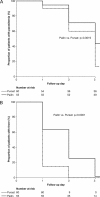Efficacy and Safety of Pyronaridine-Artesunate for Treatment of Uncomplicated Plasmodium falciparum Malaria in Western Cambodia
- PMID: 26926629
- PMCID: PMC4914696
- DOI: 10.1128/AAC.00039-16
Efficacy and Safety of Pyronaridine-Artesunate for Treatment of Uncomplicated Plasmodium falciparum Malaria in Western Cambodia
Abstract
Pyronaridine-artesunate efficacy for the treatment of uncomplicated Plasmodium falciparum malaria was assessed in an area of artemisinin resistance in western Cambodia. This nonrandomized, single-arm, observational study was conducted between 2014 and 2015. Eligible patients were adults or children with microscopically confirmed P. falciparum infection and fever. Patients received pyronaridine-artesunate once daily for 3 days, dosed according to body weight. The primary outcome was an adequate clinical and parasitological response (ACPR) on day 42, estimated by using Kaplan-Meier analysis, PCR adjusted to exclude reinfection. One hundred twenty-three patients were enrolled. Day 42 PCR-crude ACPRs were 87.2% (95% confidence interval [CI], 79.7 to 92.6%) for the overall study, 89.8% (95% CI, 78.8 to 95.3%) for Pursat, and 82.1% (95% CI, 68.4 to 90.2%) for Pailin. Day 42 PCR-adjusted ACPRs were 87.9% (95% CI, 80.6 to 93.2%) for the overall study, 89.8% (95% CI, 78.8 to 95.3%) for Pursat, and 84.0% (95% CI, 70.6 to 91.7%) for Pailin (P = 0.353 by a log rank test). Day 28 PCR-crude and -adjusted ACPRs were 93.2% (95% CI, 82.9 to 97.4%) and 88.1% (95% CI, 75.3 to 94.5%) for Pursat and Pailin, respectively. A significantly lower proportion of patients achieved day 3 parasite clearance in Pailin (56.4% [95% CI, 43.9 to 69.6%]) than in Pursat (86.7% [95% CI, 76.8 to 93.8%]; P = 0.0019). Fever clearance was also extended at Pailin versus Pursat (P < 0.0001). Most patients (95.9% [116/121]) harbored P. falciparum kelch13 C580Y mutant parasites. Pyronaridine-artesunate was well tolerated; mild increases in hepatic transaminase levels were consistent with data from previous reports. Pyronaridine-artesunate efficacy was below the World Health Organization-recommended threshold at day 42 for medicines with a long half-life (90%) for first-line treatment of P. falciparum malaria in western Cambodia despite high efficacy elsewhere in Asia and Africa. (This study has been registered at ClinicalTrials.gov under registration number NCT02389439.).
Copyright © 2016, American Society for Microbiology. All Rights Reserved.
Figures


References
-
- Denis MB, Tsuyuoka R, Poravuth Y, Narann TS, Seila S, Lim C, Incardona S, Lim P, Sem R, Socheat D, Christophel EM, Ringwald P. 2006. Surveillance of the efficacy of artesunate and mefloquine combination for the treatment of uncomplicated falciparum malaria in Cambodia. Trop Med Int Health 11:1360–1366. doi:10.1111/j.1365-3156.2006.01690.x. - DOI - PubMed
-
- Alker AP, Lim P, Sem R, Shah NK, Yi P, Bouth DM, Tsuyuoka R, Maguire JD, Fandeur T, Ariey F, Wongsrichanalai C, Meshnick SR. 2007. Pfmdr1 and in vivo resistance to artesunate-mefloquine in falciparum malaria on the Cambodian-Thai border. Am J Trop Med Hyg 76:641–647. - PubMed
-
- Chaorattanakawee S, Saunders DL, Sea D, Chanarat N, Yingyuen K, Sundrakes S, Saingam P, Buathong N, Sriwichai S, Chann S, Se Y, Yom Y, Heng TK, Kong N, Kuntawunginn W, Tangthongchaiwiriya K, Jacob C, Takala-Harrison S, Plowe C, Lin JT, Chuor CM, Prom S, Tyner SD, Gosi P, Teja-Isavadharm P, Lon C, Lanteri CA. 2015. Ex vivo drug susceptibility testing and molecular profiling of clinical Plasmodium falciparum isolates from Cambodia from 2008 to 2013 suggest emerging piperaquine resistance. Antimicrob Agents Chemother 59:4631–4643. doi:10.1128/AAC.00366-15. - DOI - PMC - PubMed
-
- Leang R, Taylor WR, Bouth DM, Song L, Tarning J, Char MC, Kim S, Witkowski B, Duru V, Domergue A, Khim N, Ringwald P, Menard D. 2015. Evidence of Plasmodium falciparum malaria multidrug resistance to artemisinin and piperaquine in western Cambodia: dihydroartemisinin-piperaquine open-label multicenter clinical assessment. Antimicrob Agents Chemother 59:4719–4726. doi:10.1128/AAC.00835-15. - DOI - PMC - PubMed
MeSH terms
Substances
Associated data
Grants and funding
LinkOut - more resources
Full Text Sources
Other Literature Sources
Medical

